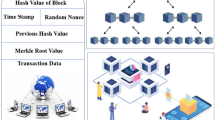Abstract
Identity based proxy re-encryption (IB-PRE) is a powerful cryptographic primitive, which allows a proxy to transform a ciphertext under Alice’s identity to another ciphertext of the same message for Bob. Almost all of the existing IB-PRE schemes are based on the number theoretic assumptions whose security will be seriously threatened by quantum computers. Recently, cryptosystems from lattices have attracted many attentions due to their average-case to worst-case equivalence and their conjectured resistance to quantum attacks. In this paper, we first propose a property of backward collusion safety, which means that the collusion between Alice and the proxy cannot extract secret key of Bob, and then present an IB-PRE scheme based on lattices with the highly desirable properties of anonymity, uni-directionality, multi-use and backward collusion safety, to the best of our knowledge, it is the first IB-PRE scheme from lattices which provides those properties. Besides, the IND-PrID-CPA security proof of our proposal is given in the random oracle model based on the decisional learning with errors hardness assumption.

Similar content being viewed by others
References
Aono Y, Boyen X, Phong L, Wang L (2013) Key-private proxy re-encryption under LWE. In: INDOCRYPT’13. LNCS, vol 8250, pp 1–18
Applebaum B, Cash D, Peikert C, Sahai A (2009) Fast cryptographic primitives and circular-secure encryption based on hard learning problems. In: CRYPTO’09. LNCS, vol 5677, pp 595–618
Ateniese G, Fu K, Green M, Hohenberger S (2005) Improved proxy re-encryption schemes with applications to secure distributed storage. In: NDSS’05, pp 29–43
Benhamouda F, Camenisch J, Krenn S, Lyubashevsky V, Neven G (2014) Better zero-knowledge proofs for lattice encryption and their application to group signatures. In: AISACRYPT’14. LNCS, vol 8874, pp 551–572
Blaze M, Bleumer G, Strauss M (1998) Divertible protocols and atomic proxy cryptography. In: Eurocrypt’98. LNCS, vol 1403, pp 127–144
Brakerski Z, Langlois A, Peikert C, Regev O, Stehle D (2013) Classical hardness of learning with errors. In: STOC’13, pp 575–584
Chu CK, Tzeng WG (2007) Proxy re-encryption systems for identity-based encryption. In: ISC’07. LNCS, vol 4575, pp 247–267
Craig G, Peikert C, Vaikuntanathan V (2008) Trapdoors for hard lattices and new cryptographic constructions. In: STOC’08, pp 197–206
Ducas L, Lyubashevsky V, Prest T (2014) Efficient identity-based encryption over NTRU lattices. In: AISACRYPT’14. LNCS, vol 8874, pp 22–41
Gentry C (2009) Fully homomorphic encryption using ideal lattices. In: STOC’09, pp 169–178
Green M, Ateniese G (2007) Identity-based proxy re-encryption. In: ACNS’07. LNCS, vol 4521, pp 288–306
Kirshanova E (2014) Proxy re-encryption from lattices. In: PKC’14. LNCS, vol 8383, pp 77–94
Kunwar S, Pandu R, Banerjee A (2014) Lattice based identity based proxy re-encryption scheme. J Internet Serv Inf Secur (JISIS) 3(3/4):38–51
Kunwar S, Rangan C Pandu, Banerjee AK (2014) Lattice based identity based unidirectional proxy re-encryption scheme. In: SPACE’14. LNCS, vol 8804. Springer, pp 76–91
Ling S, Phan DH, Stehle D, Steinfeld R (2014) Hardness of k-LWE and applications in traitor tracing. In: CRYPTO’14. LNCS, vol 8616, pp 315–334
Micciancio D, Peikert C (2012) Trapdoors for lattices: simpler, tighter, faster, smaller. In: EUROCRYPT’12. LNCS, vol 7237. Springer, Berlin, pp 700–718
Regev O (2005) On lattice, learning with errors. Random linear codes, and cryptography. In: STOC’05, pp 84–93
Shao J, Xing D, Cao ZF (2008) Identity-based proxy re-encryption schemes with multiuse, unidirection, and CCA security. Cryptology ePrint Archive, Report 2008/103
Wang LH, Wang LC, Masahiro M, Eiji O (2010) New identity-based proxy re-encryption schemes to prevent collusion attacks. In: Pairing’10. LNCS, vol 6487, pp 327–346
Xagawa K (2010) Cryptography with lattices. PhD thesis, Tokyo Institute of Technology, Tokyo
Acknowledgments
X. A. Wang is the corresponding author. This work is supported by the National Natural Science Foundation of China (Grant Nos. 61103230, 61272492, 61103231, 61402531). It is also supported by the Natural Science Foundation of Shaanxi Province (Grant Nos. 2014JM8300, 2014JQ8358, 2014JQ8307).
Author information
Authors and Affiliations
Corresponding author
Rights and permissions
About this article
Cite this article
Zhang, M., Wu, L., Wang, X.A. et al. Unidirectional IBPRE scheme from lattice for cloud computation. J Ambient Intell Human Comput 7, 623–631 (2016). https://doi.org/10.1007/s12652-015-0260-4
Received:
Accepted:
Published:
Issue Date:
DOI: https://doi.org/10.1007/s12652-015-0260-4




